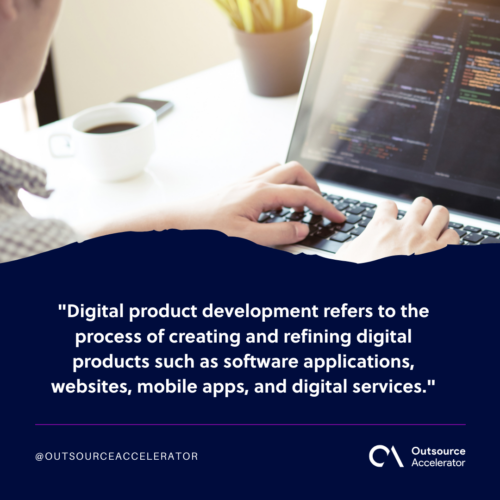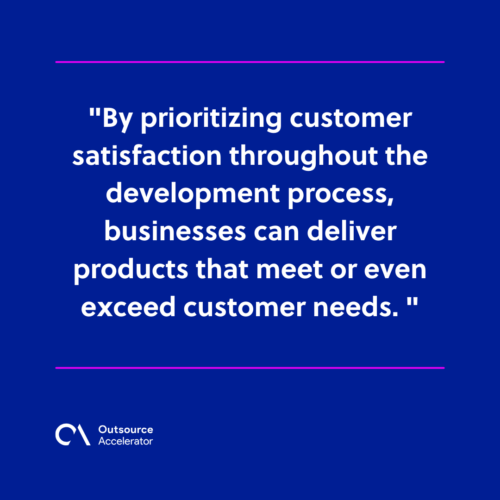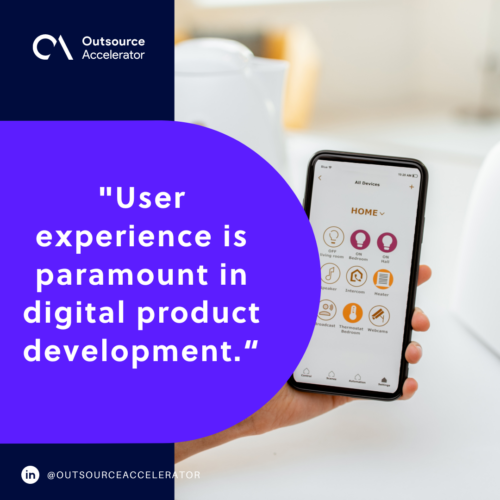A quick guide to digital product development

Creating successful digital products has become essential for businesses to thrive.
More organizations are creating apps to promote their services, while small businesses are interested in doing so but don’t know where to start.
Understanding the process of digital product development is key to building a successful digital product for these firms.
In this guide, we will explore what digital product development entails and give you some tips to help you create a winning development strategy.
What is digital product development?
Digital product development refers to the process of creating and refining digital products such as software applications, websites, mobile apps, and digital services.
It involves a systematic approach to delivering high-quality, user-friendly products that meet customer needs and align with business objectives.

Benefits of digital product development
Digital product development provides various benefits, such as the following:
Improved productivity
One of the key benefits of digital product development is the enhanced productivity it brings.
Through a structured development process, teams can streamline workflows and achieve higher levels of efficiency. This streamlined approach accelerates development cycles and ultimately leads to improved overall productivity.
A better alliance between teams
Digital product development fosters better alliance and collaboration between different teams involved in the process.
Harmonious collaboration allows each team to leverage their unique skills and expertise. As a result, every team works according to their task, from designers and developers to marketers and project managers.
The result is a cohesive and well-rounded product that meets customer expectations and drives business growth.
Faster production process
Digital product development enables companies to shorten their production cycles and accelerate time to market.
A speedier production process allows businesses to respond quickly to market demands and outpace their competitors.
Through a systematic approach, companies can swiftly move from ideation to launch. This reduces unnecessary delays and maximizes their competitive advantage.
Enhanced customer satisfaction
Most importantly, digital product development places great emphasis on understanding customer needs and preferences.
Thorough research, testing, and validation provide valuable insights into user preferences, pain points, and expectations.
By prioritizing customer satisfaction throughout the development process, businesses can deliver products that meet or even exceed customer needs. This move ultimately builds a loyal customer base.

Stages of digital product development
Digital product development undergoes several processes to make an application come to life.
Ideation and preparation
The first stage of digital product development involves generating ideas, outlining the product vision, and conducting thorough preparation.
The ideation phase is the time to brainstorm what digital product can be created to solve a specific market issue. Here, teams conduct market research and define goals in creating their product.
Research
Research plays a critical role in digital product development. It helps identify user needs, market trends, and potential challenges.
Product research can be done through surveys, interviews, and market analysis. Businesses gather insights from their market data, ensuring the product aligns with customer expectations.
Prototyping
Prototyping involves creating a preliminary version of the product through wireframes, mockups, or interactive prototypes.
Prototyping allows teams to visualize and test the product’s functionality, user interface, and user experience early on. This iterative process helps identify areas for improvement and ensures the final product meets customer expectations.
Design
Design is where the vision for the product comes to life visually. It encompasses both the user interface (UI) and user experience (UX) design.
UI design focuses on the aesthetic appeal and usability of the product, while UX design ensures a seamless and enjoyable user journey.
Well-designed digital products enhance user engagement and satisfaction, making design a crucial stage of development.
Testing and validation
Testing and validation guarantee that the product meets the quality standards of an organization.
This process helps refine the product and eliminate potential hurdles before launch. Firms can identify and address any issues or bugs by conducting rigorous tests and usability studies and gathering feedback from early users.
Development
In the development stage, the product moves from design and prototyping to becoming a fully functional digital product.
Skilled developers work on coding, integrating various components, and implementing necessary features. Effective project management and regular communication between teams are vital to ensure a smooth development process.
Launch
The final stage of digital product development is the product launch. This involves deploying the product to the market, promoting it to the target audience, and monitoring its performance.
A successful launch requires effective marketing strategies, leveraging digital channels, and continuous improvement based on user feedback.
Tips for creating a digital product development strategy
To create a winning digital product development strategy, consider the following tips:
Foster cross-functional collaboration
Encourage open communication and collaboration between different teams involved in the product development process. This allows for the seamless integration of various skills and enhances overall product quality.
Prioritize user experience
User experience is paramount in digital product development. Make it a top priority at every stage of development, from design to testing and validation.

Continuously test and iterate
Regularly gather feedback from users, conduct A/B testing, and make iterative improvements to your product. This allows you to fine-tune your product based on real user insights, resulting in a more refined final product.
Stay updated with industry trends
Keep an eye on evolving industry trends, emerging technologies, and competitor offerings.
Staying informed about the latest advancements will help you innovate and ensure your product remains at the forefront of the market.
Digital product development is a dynamic and multifaceted process that requires careful planning, collaboration, and customer-centricity.
By implementing an effective strategy, you can create digital products that resonate with your target audience and drive business success in the digital age.







 Independent
Independent




